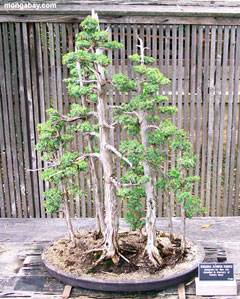Researchers create mutant midget trees through genetic modification
Researchers create mutant midget trees through genetic modification
mongabay.com
June 18, 2007
Researchers have used genetic modification to manipulate the growth in height of trees, a development that could lead to miniature trees and a variety of new ornamental plants, reports Oregon State University.
“From a science perspective, this is a very interesting accomplishment and there’s no doubt it could be made to work,” said Steven Strauss, a professor of forest science at OSU.
“But further development may be precluded by social, legal and regulatory obstacles. Clearly there would be concerns whether the market for specialty tree products such as this would be strong enough to make it worth the large investments of time, money and testing that current regulation of genetically modified organisms would require, at least in the U.S.”

Bonsai sequoia tree. The genetically modified trees are not manipulated through bonsai cutting techniques. |
Strauss says it may soon be possible to create an elm tree — which normally reaches 100 feet in height— that is only five feet tall at maturity.
The researchers used genetic engineering to create the dwarfed trees.
“The manipulation of height growth was achieved by insertion of certain genes, mostly taken from the model plant Arabidopsis, which inhibited the action of a class of plant-specific hormones known as gibberellic acids,” explained a statement from OSU. “These compounds are also used as sprays to control the size and fruiting of orchard trees. In trees, the compounds promote the elongation of plant cells — when they are inhibited, the cells do not fully elongate, and plants remain short and stocky.”
The findings are published in the journal Landscape Plant News.







